September 16th, 2015
Summer is still with us but the presence of Autumn is all around. The changing of the colours begins to mute the delightful backdrop of the South Downs. Mists but no mellow fruitfulness just yet. How lucky indeed to be able to enjoy this transition.
In a previous life I ran a commercial service based business, or should I say, I ran and ran and ran. I ran quite often just to stay in the same place. Nothing in commerce stays at the same level. It either improves through action or deteriorates through lack of it. The “iterative” process of development is vital to success. So we are looking at ways of improving the beepalace. New ideas on how the nesting tubes are fixed and new ideas on materials, as well as new products. This should translate into modifications to the beepalace and innovations that will be of interest to current owners and future ones.
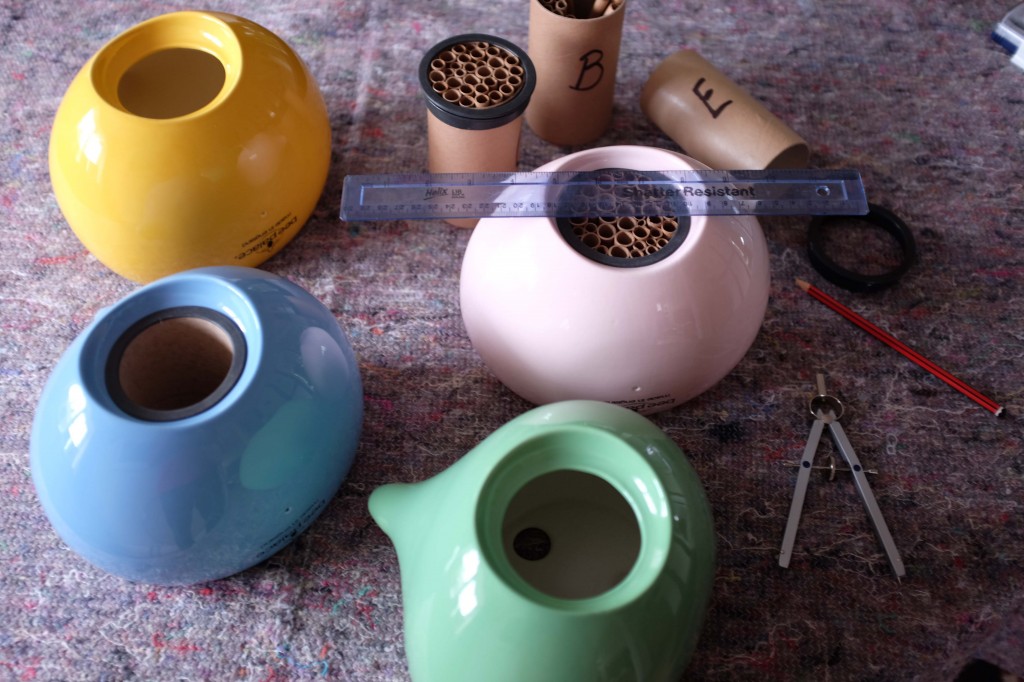
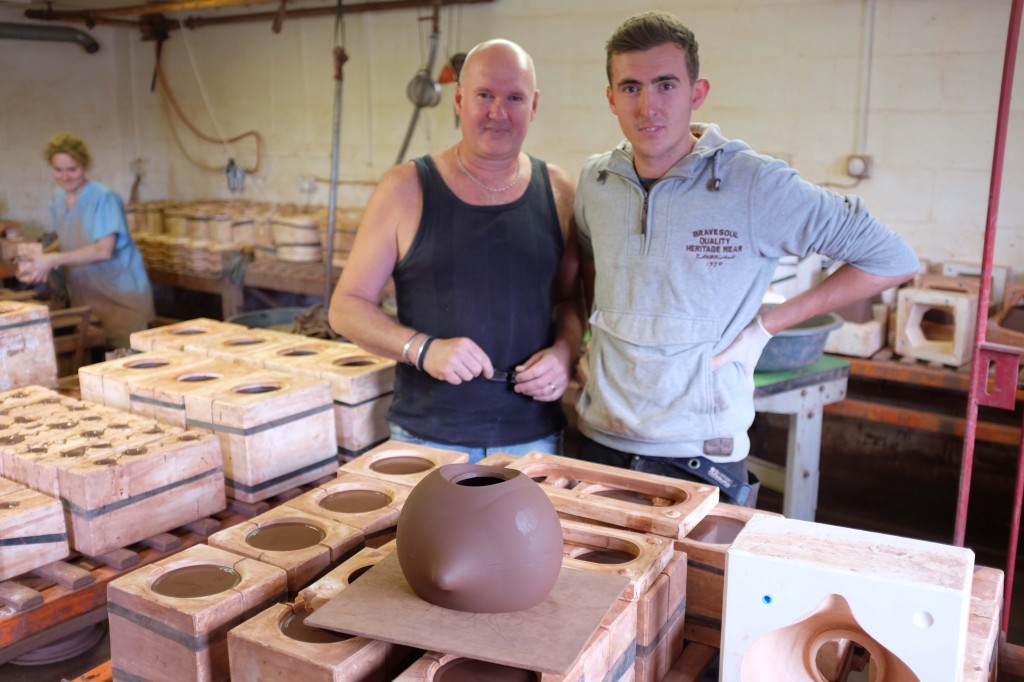
Above: technical work on the nesting tubes and a sample beepalace in terracotta.
At a recent event where we were displaying the beepalace I was asked by a very knowledgeable wild life expert how the show was going. Not bad, I said, I’m talking to a lot of people but we haven’t sold that many beepalaces. Think of all the good you are doing, he replied. Oh yes, I said, we’ll have a great mailing list by the end of the day. No, not that he said, think of all the people you are educating about how important solitary bees are as pollinators. Talk about solitary! Sometimes the commercial and higher minded edges can blur. A salutary lesson!
In this blog, it isn’t appropriate to dwell, pontificate, make judgements on the plight of the thousands of refugees fleeing their homes and countries. Whilst I count myself very fortunate not to be one of them I hope I will do enough to make some difference to some of them.
Posted in beepalace, craftsmen, Garden Landscaping, Gift idea, Solitary bees
No Comments »
May 18th, 2015
Spring has been a little hit and miss but we have seen very high levels of activity in the garden. When we have learnt how to post a video we will share some very lively clips! Can anyone help? It’s an age thing!
We attended the Firle Garden Show since I wrote here last. It was very disappointing. Hidden away in a cavernous marquee with a mish mash of stalls it isn’t an experience we want to repeat. All the stallholders were good company but the crowds we were expecting did not materialise. A great shame as Firle is such a lovely spot. Nevertheless two nights at The Rose Cottage Inn, Alciston went some way to make up for it, tho Nicks stay at the Hilton, Eastbourne wasn’t quite the Park Lane experience he had been hoping for!
The title of this piece is taken from an article by Luke Johnson (serial entrepreneur) in the Sunday Times. He talks about old craft skills being revived in Britain and “a hunger for real products and a rejection of a disposable culture”. We wholeheartedly support this. The beepalace is made in Stoke-on-Trent and is entirely made in England. It should last a lifetime (unless dropped from a height). It comes at a cost because a lot of time goes into making one. From the model and moulds required for it to be slip cast and glazed to it being hand assembled. It is time consuming and we have sourced what we think are the best quality materials (Kew Gardens share the same nesting tube maker that we use).
Britain has a long tradition for making quality goods. Things that are thought through and designed to look beautiful and to last. We are really proud to be part of this movement.
You may have seen Nick driving our natty van around the Hampshire highways and bye ways – if you see it be sure to give him a toot – that should keep him awake!
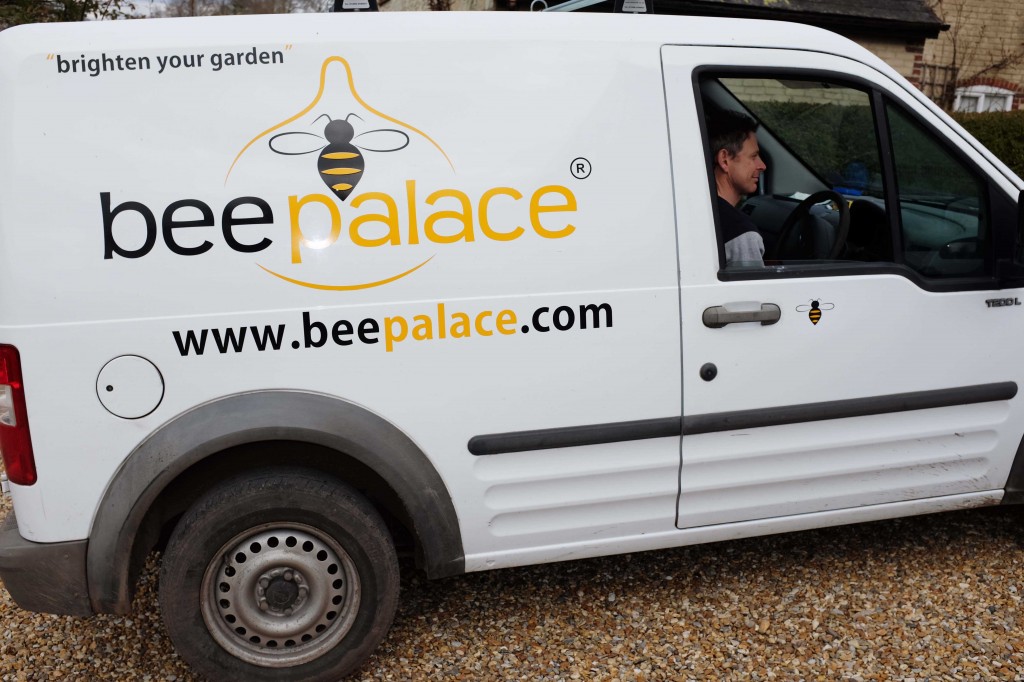
There are some new colours we have added to the range of beepalaces which we hope will go with most types of outdoor spaces. Sage and Ochre are proving very popular.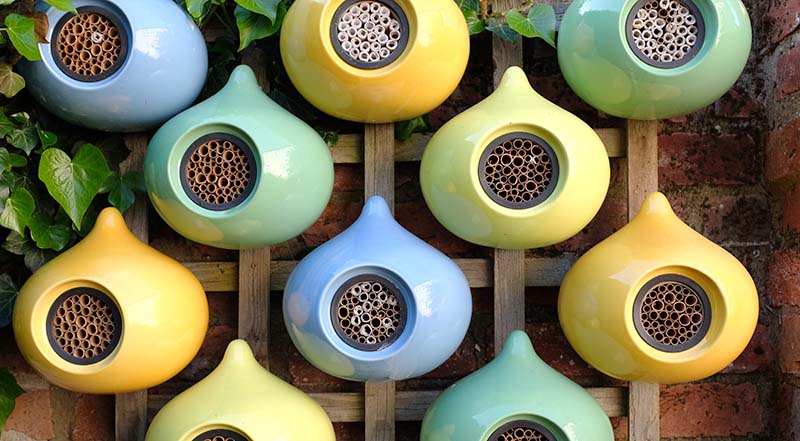 Our next Garden Show is at Stansted Park 5-7 June. We hope we might see you there!
Our next Garden Show is at Stansted Park 5-7 June. We hope we might see you there!
Posted in beepalace, craftsmen, Fairs and Shows, Garden Gift, Garden Landscaping, Gift idea, Pollinator Initiatives, Pollinators, Solitary bees
No Comments »
March 20th, 2015
Early in the year things are quiet on the nesting front and whilst we are busy preparing the new stock for the Spring, we much prefer the warm weather and the buzz of the bees. Even to-day when we were expecting the solar eclipse and what an amazing experience that would be – it was just another grey overcast day!
Our new nesting tubes have arrived and as well as providing a better combination of tube sizes for bees to chose from they allow us to pack the beepalaces more tightly and they look even better!
The reaction we have had from people seeing the beepalaces has been fantastic. There is a huge amount of work to be done to explain the importance of solitary bees to our food supplies and our general well being and the beepalace is a wonderful vehicle to help do this.
We were particularly pleased when Alitex (www.alitex.co.uk), a very established maker of Conservatories and Greenhouses expressed interest in having one in their garden. Alitex, a near neighbour of the beepalace,based just outside Petersfield have an outstanding reputation and work closely with The National Trust and The Royal Botanic Gardens in Kew so we are extremely chuffed that they are going to blog about the beepalace they have recently hung up. We have given it a head start by inserting some full nesting tubes from last year – in a month or two we should see some action!
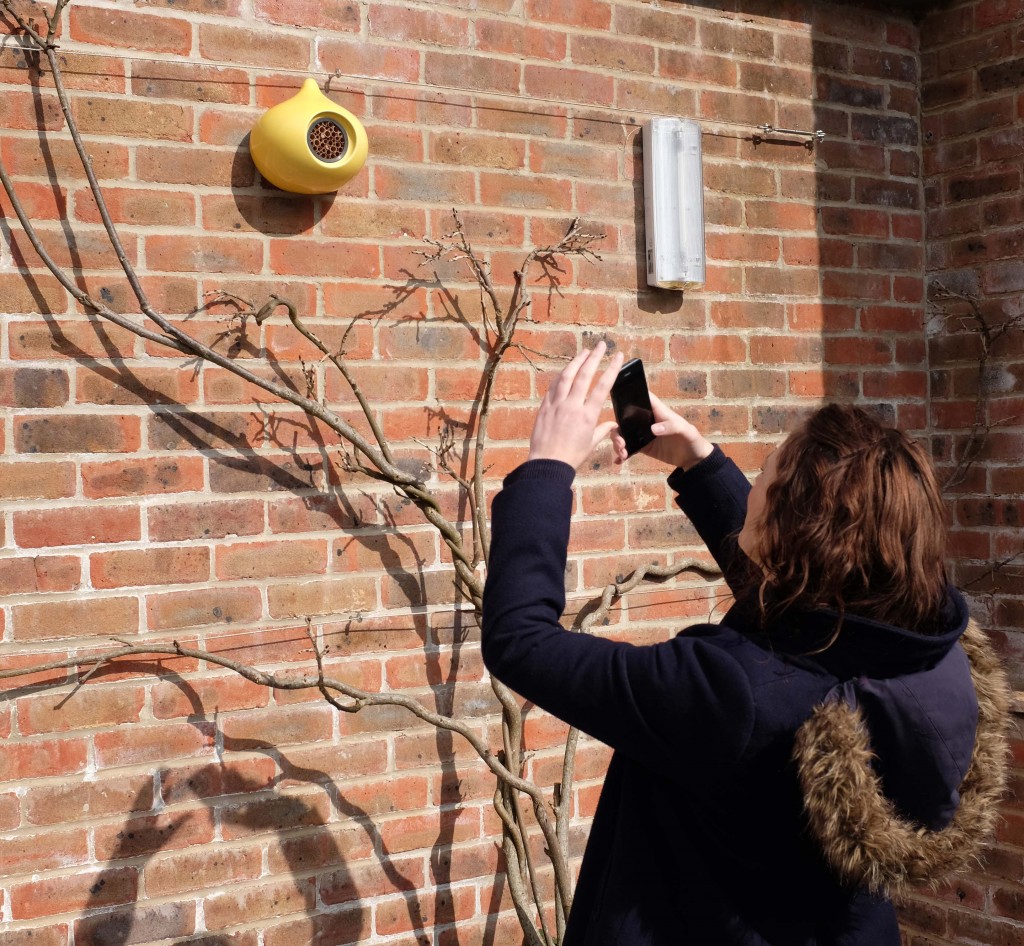
This is a picture of Sam Duke from Alitex taking the first picture of their new beepalace – she will be blogging and tweeting about their experience of it. Thanks Sam!
Thanks also to Mandy at Wild Damson in Petersfield (www.wilddamsom.co.uk) for suggesting we contacted Alitex and also for letting us have some space for the beepalace in her incredibly busy shop.
The new colours should be arriving next week just in time for the Garden Shows we are attending, the first one being at Firle Place, Firle, near Lewes BN8 6LP 24 – 26th April. Its a ovely part of the country with a great pub and superb walks – in case you want a change from looking at gardening products. Charleston House, home and retreat to some of the “Bloomsbury Set” is a short distance away – in case you want a change from the pub and walking.
Chris Evans was talking about solitary bees on his BBC2 morning show recently – solitary bees will be coming out of the woodwork!! Yes, quite literally!
Posted in Alitex, beepalace, Garden Gift, Garden Landscaping, Garden retail, Gift idea, Solitary bees
No Comments »
October 7th, 2014
We first went to the Eden project on our way to a wedding in Cornwall in 2002. It was about a year after they had opened their doors to the public. The bio-domes looked impressive but the landscaping was still raw. The Mediterranean bio-dome was sparse and the Tropical Rain Forest in its infancy . Seeing it again 12 years on was quite an experience. Our first visit lasted a couple of hours and we said how we thought Tim Smit’s achievement was phenomenal and hoped that it worked. This time we spent 6 hours and could have stayed longer. The Core was full of innovative ways to educate people on environmental matters and contains some great Heath Robinsonesque (!) contraptions.
The Eden Project’s take on bees is geared towards honey bees though they don’t admit to that! Biodiversity means championing all of nature, but solitary bees are a footnote in the projects scheme. The Cornish Black Honey Bees are something of a favourite in these parts – perhaps not unsurprisingly! Apis mellifera mellifera, as the Cornish Black Honey Bees are called in the senior common room, are the original bees of the British Isles
The Cornish Black Honey Bees are also a cause taken up by the Duchy Estate and 20 colonies are being established on Duchy land. Wouldn’t you like to have the heir to the throne championing your cause!
It would be nice if the Eden project would bang the drum for solitary bees a bit louder – but with a host of other pollinators needing more publicity it is easy to see why the honey bee gets most of the press.
The Eden Project is a fantastic place to visit. We stayed at The King Of Prussia in Fowey which is less than 30 minutes away – very pleasant place to sip a jar or two of Tribute.
We are preparing for the Autumn Show at the Weald and Downland Museum this weekend. Another great place to visit. Here are some pictures of the Eden Project’s take on pollination and bees (plus a gratuitous picture of a very tame Robin).
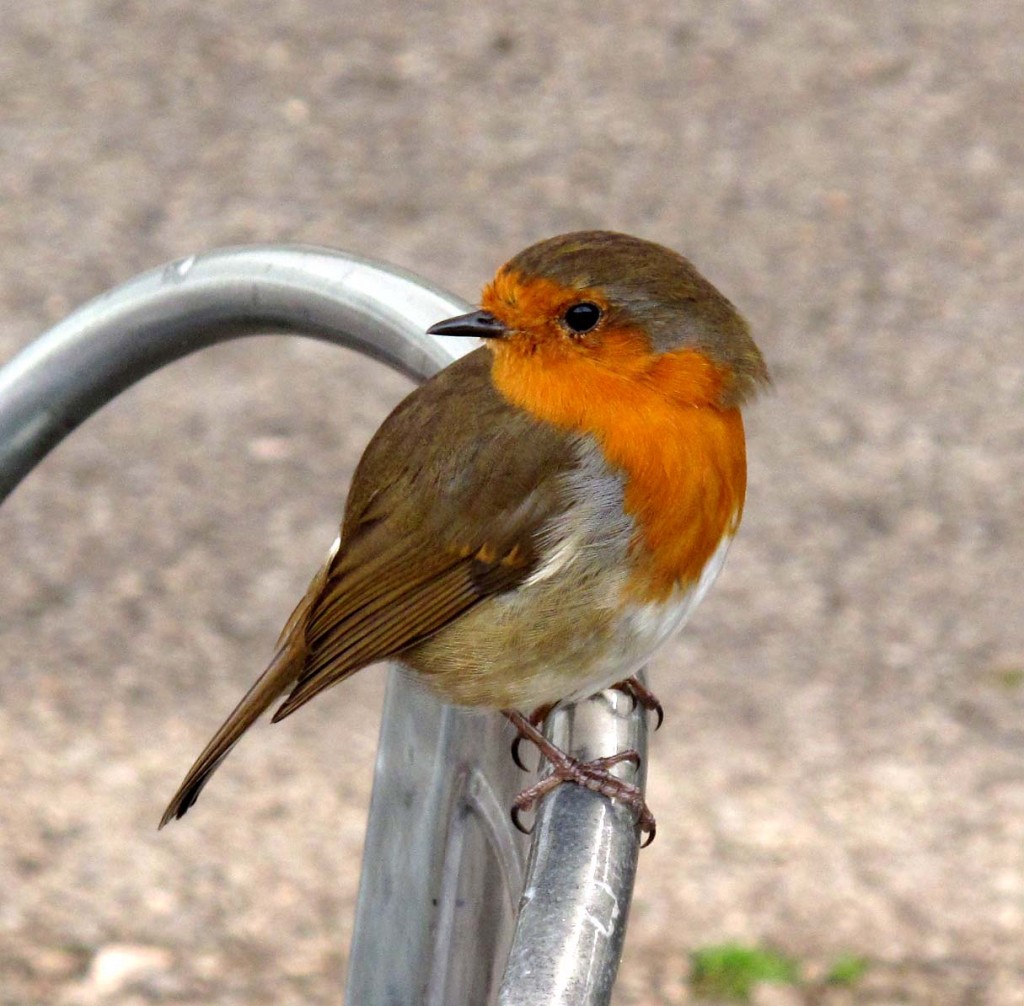
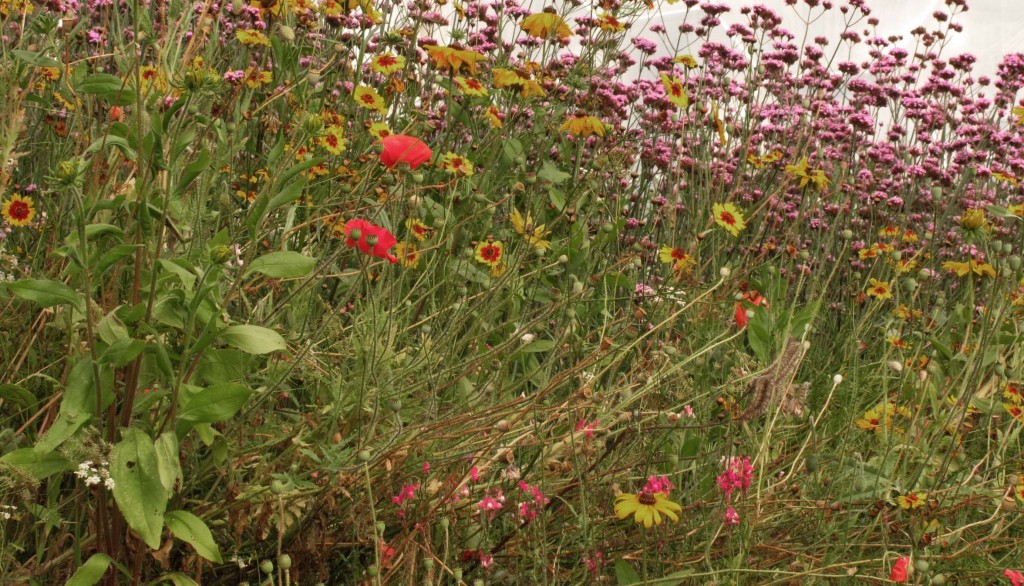
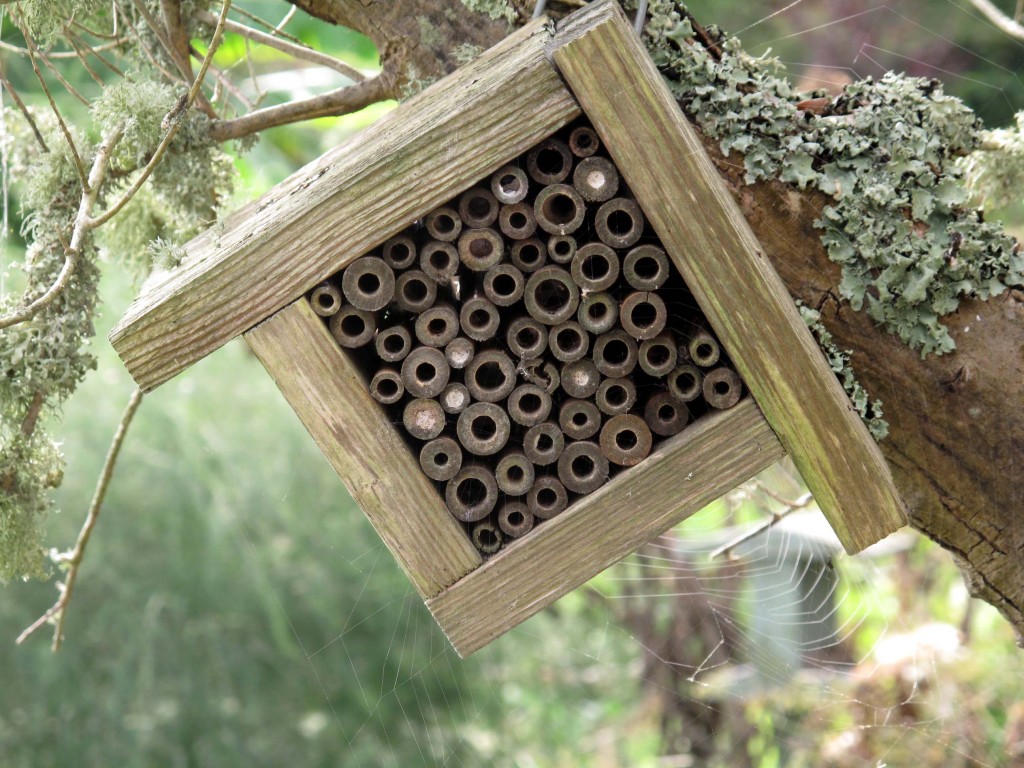
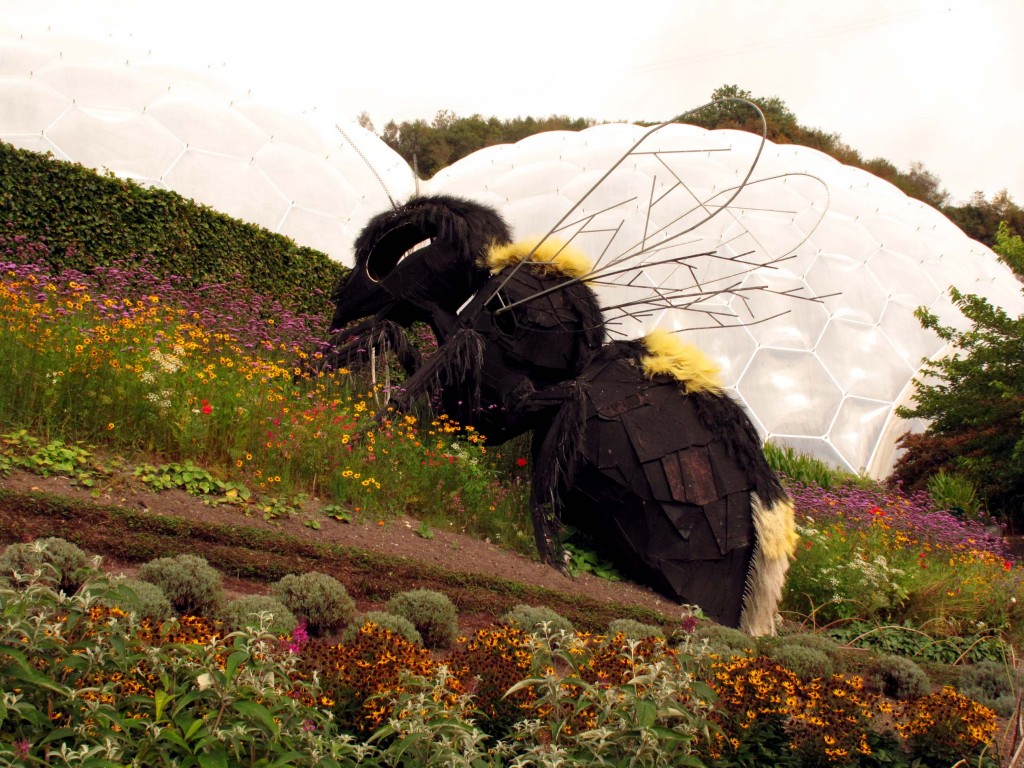
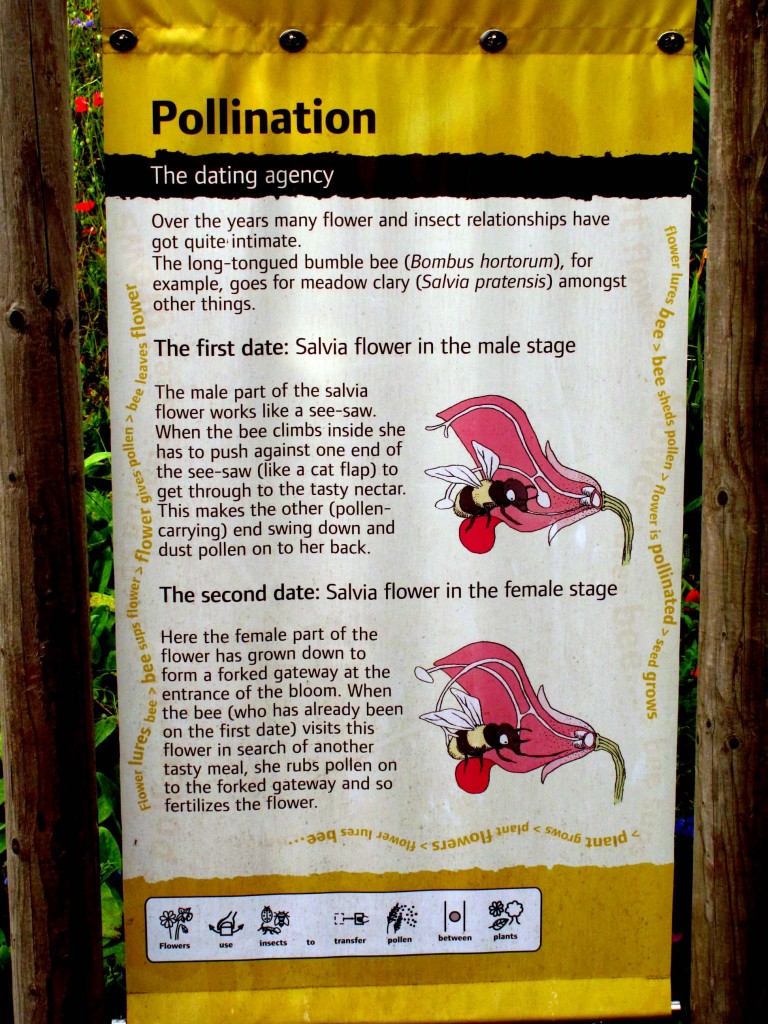
Posted in Garden Landscaping, Pollinator Initiatives, Pollinators, The Eden Project
No Comments »
September 8th, 2014
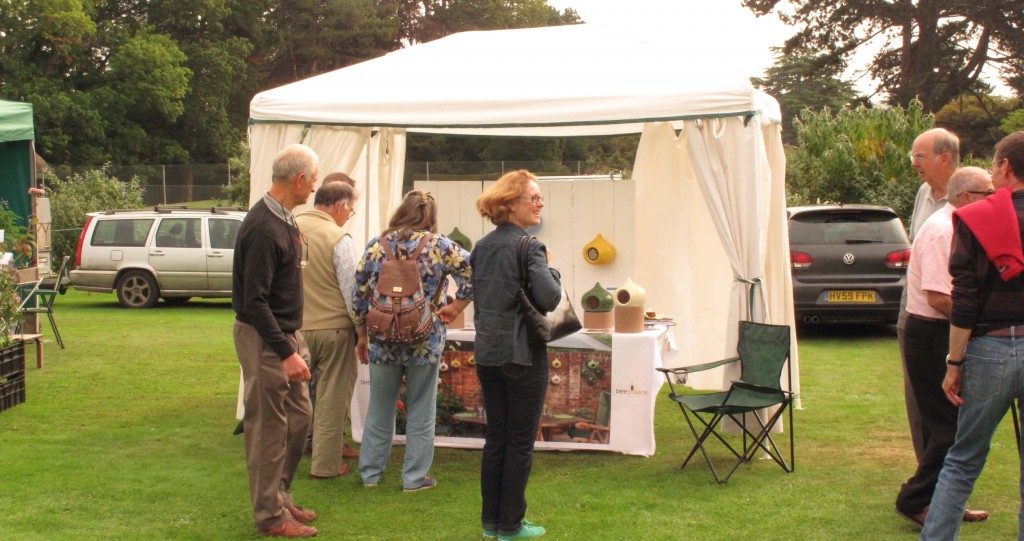
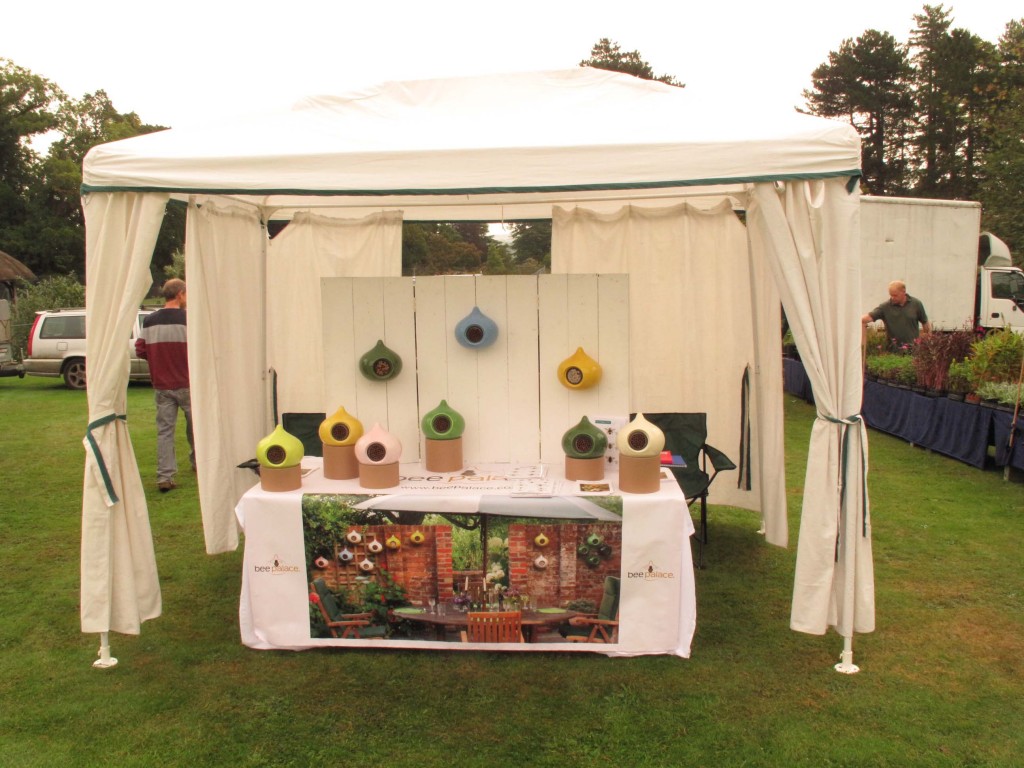
We attended the Longstock Plant and Gift Fair near Stockbridge, Hampshire. Set in the magnificent grounds originally owned by the eponymous John Lewis we had a great day. The sun shone and everyone seemed to be enjoying themselves. Our day started with a wrestling match against an old style gazebo. Nick and I managed to win although the gazebo had some good moves.
The Longstock Plant and Gift Fair (now in its seventh year I think) is very popular for plant buyers and local nurseries provide a lot of the colour. Our neighbour at the event has a half acre nursery (that is small) and attends 50 Fairs a year!) A band played what seemed like an 8 hour set of popular ballads and the queue for hog roast never seemed to get any shorter.
The event was really well organised and is a great day out. There is an excellent café run by Waitrose and a Farm Shop. The Water Gardens are worth a visit tho we didn’t make it there so busy were we describing the life cycle of solitary bees.
We met a lot of lovely people a good number of whom bought Beepalaces (Dark Green was the favourite colour) and even more were quite gushing about the attractiveness of the design – all very encouraging. 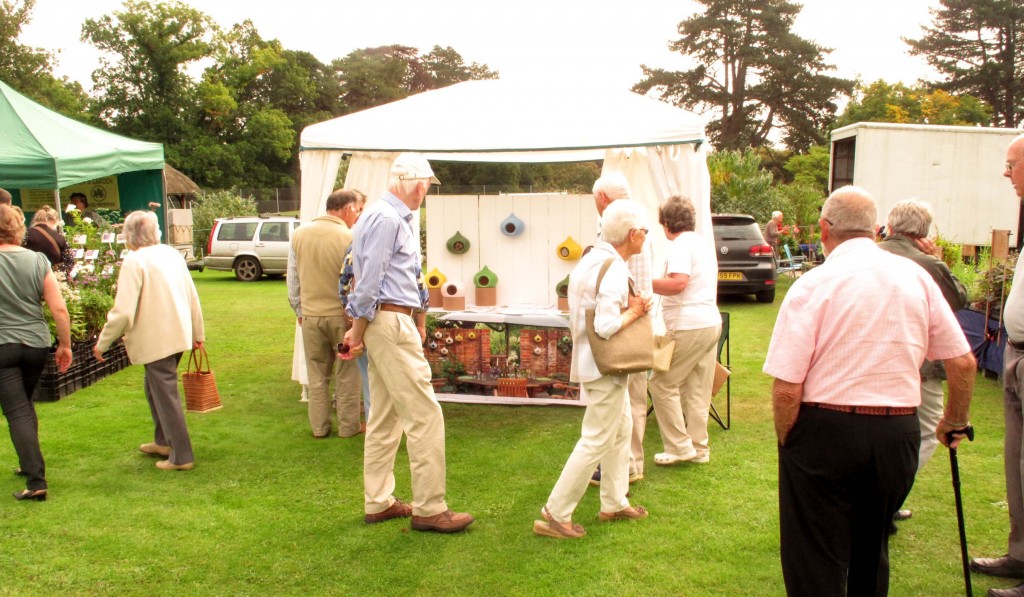
Here are some pics of the day.
Our next big day out is at the Weald and Down Museum near Goodwood on the 11th and 12th October.
Posted in Fairs and Shows, Garden Landscaping, Garden retail
No Comments »
August 22nd, 2014
The Beepalace is beginning to get an airing. We have been delighted by all the positive comments and growing sales on line but felt that on-line sales were not enough.We really enjoy engaging with the public and have met some wonderful people when we have been out and about with the Beepalaces. We are a commercial company so we are selling a product but we are also educating people on the importance of one of the most crucial pollinators on our planet. Most of the people we talk to have no idea what a solitary bee is. That isn’t surprising as it has always been the honey bees that have had the limelight. The unsung heroes ( and we should include all sorts of other pollinators such as bats, butterflies, and beetles to name a few) of the pollinating world are under threat as much as honey bees (debatable?). Somehow the solitary bee has a character and it is easy to observe making it’s nest.
The Beepalace was always meant to take the story about “unsung pollinators” to a new market. People who are not necessarily knowledgeable about wildlife but who are nevertheless fascinated by the facts and want to know more.
To attract a solitary bee you could drill holes in a piece of wood and if it is south west facing and near the right sources of pollen and nectar you will probably see the holes fill with larvae. The Beepalace was designed to be stylish, last a lifetime and add a focal point to a garden. It is attracting interest from people from all walks of life but it is perhaps the professional City dwellers who show interest that we find most rewarding. People for whom the whole world of solitary bees is a discovery a new found land.
Research into the ways of bees, their predicament and how we can improve their life chances is becoming more important by the day. There is a a realization that we are dangerously close to destroying those things that we should hold most dear (enter King Lear!). We hope that people will find the Beepalace an education as much as a stylish object.
We will be attending the Weald and Downland Open Air Museum Autumn Countryside Show and Christmas Market, the Stansted Park Christmas Fayre 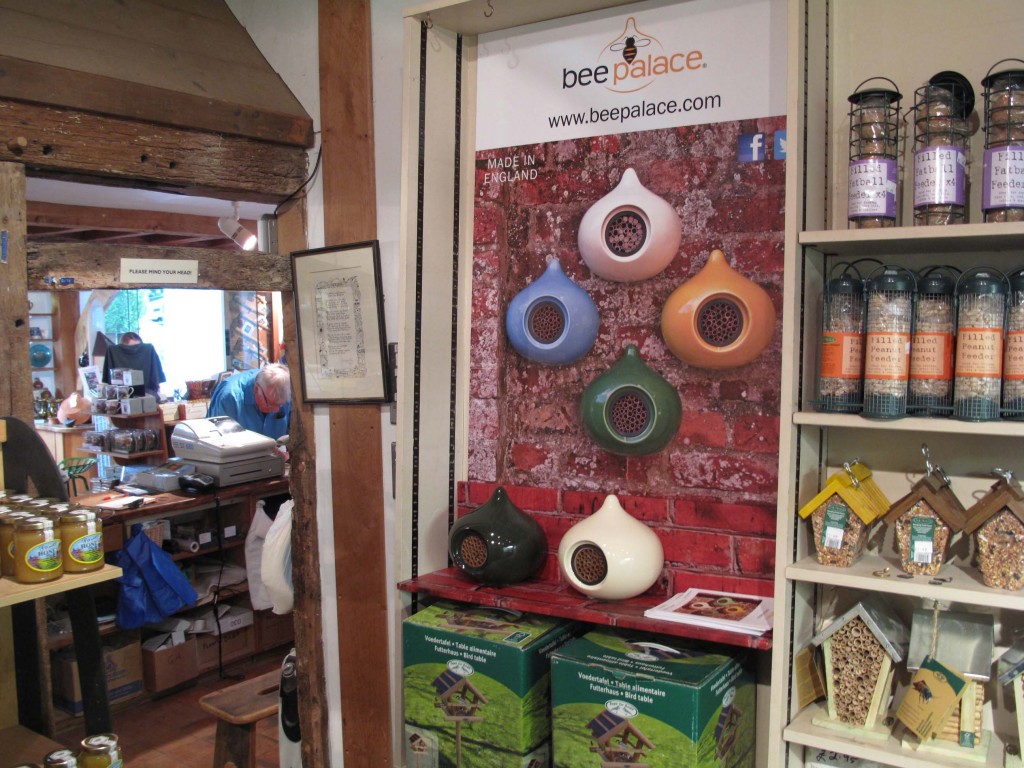 (www.stanstedpark.co.uk) and in a couple of weeks we will be at the Longstock Park Nursery (in aid of the North Hampshire medical Fund).
(www.stanstedpark.co.uk) and in a couple of weeks we will be at the Longstock Park Nursery (in aid of the North Hampshire medical Fund).
In the meantime here is a picture of our display at the Weald and Downland Open Air Museum Shop (www.wealddown.co.uk). The display was made for us by some very nice people at Cathedral Signs, Chichester (www.cathedralsigns.co.uk).
Posted in Garden Landscaping, Garden retail
No Comments »
August 2nd, 2014
We have had our beepalaces up in West Sussex since the Spring. It’s been fun watching the bees setting up home. The red mason bees were the first to arrive. They came in good numbers and there appeared to be some territorial disputes – it’s hard to tell one tube from another!
One tube would take about three days to be completed with the final mud plug – does that give some sort of satisfaction to the bee? It did for us! There was a period when the tree bumblebees dominated the garden and the red masons backed off. Activity resumed again and we have around 90 full tubes. Assuming there are 8 larvae in a tube and they are split equally between male and female then we should have at least 360 female red masons to help pollinate the garden next year. Assuming of the 360 just 25% take up continue nesting next year then we would expect to fill a few more beepalaces! We’ll let you know.
The leafcutter bees came later. The rounded gouges of rose leaf look huge as they wrestle to fit them in the nesting tubes. The acrobatics would leave Nadia Comaneci with a silver (possibly not Claudia Fragapane!). The delicate looking ribbed rose leaf pellet at the end of the tube is a wonder. Has anyone calculated the equivalent in human terms for the work that goes into this amazing exercise?
We leave you with a picture of a leafcutter setting up home alongside the red masons (such lovely neighbours!).
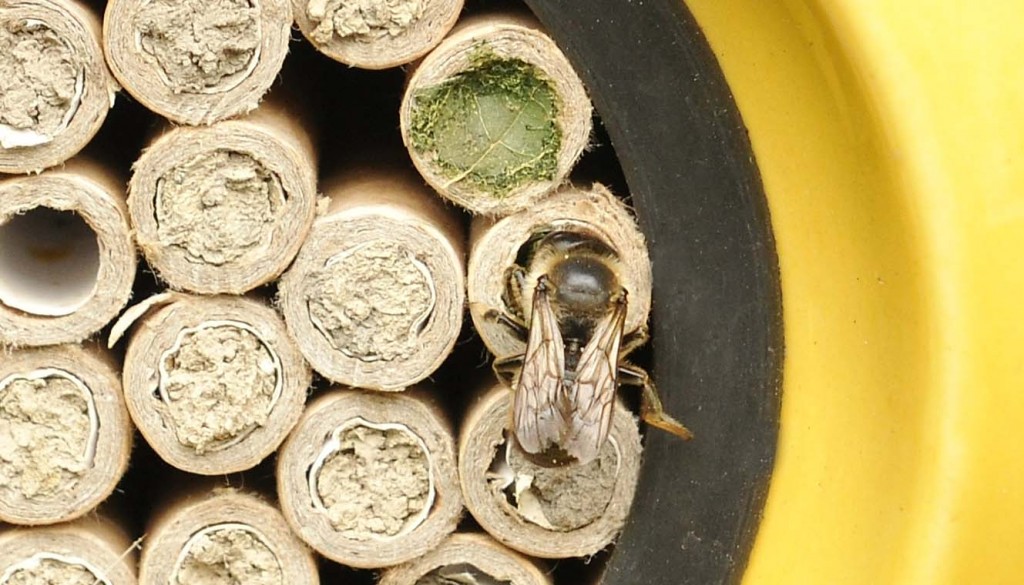
Posted in beepalace, Garden Landscaping, Pollinator Initiatives, Pollinators, Solitary bees
No Comments »
June 25th, 2014
There is no doubt that Beepalaces can brighten a garden. And they are effective as well. We have several Beepalaces in use at present. It is mainly red mason bees (osmia rufa) that have made use of them so far this year and we expect leafcutters (from the megachilidae family) to become active later in the year. They are always great to see, lugging their bits of leaf into the nesting tubes.
It is important to ensure your Beepalace is positioned in a sunny south/southwest facing direction to attract the bees. Once they have begun nesting you will usually find that future generations will pick the same spot.
Generally there have been a good number of pollinators in evidence this year with the tree bumblebee phenomenon very present – they appear to be very effective pollinators but you don’t see many other pollinators around when these girls are in town!
We have Beepalaces in blue available now (picture arriving shortly).
We have been talking to some very select retailers who have expressed interest in the Beepalaces – so the Beepalaces may be in the shops before Christmas! A unique gift for someone who has a garden.
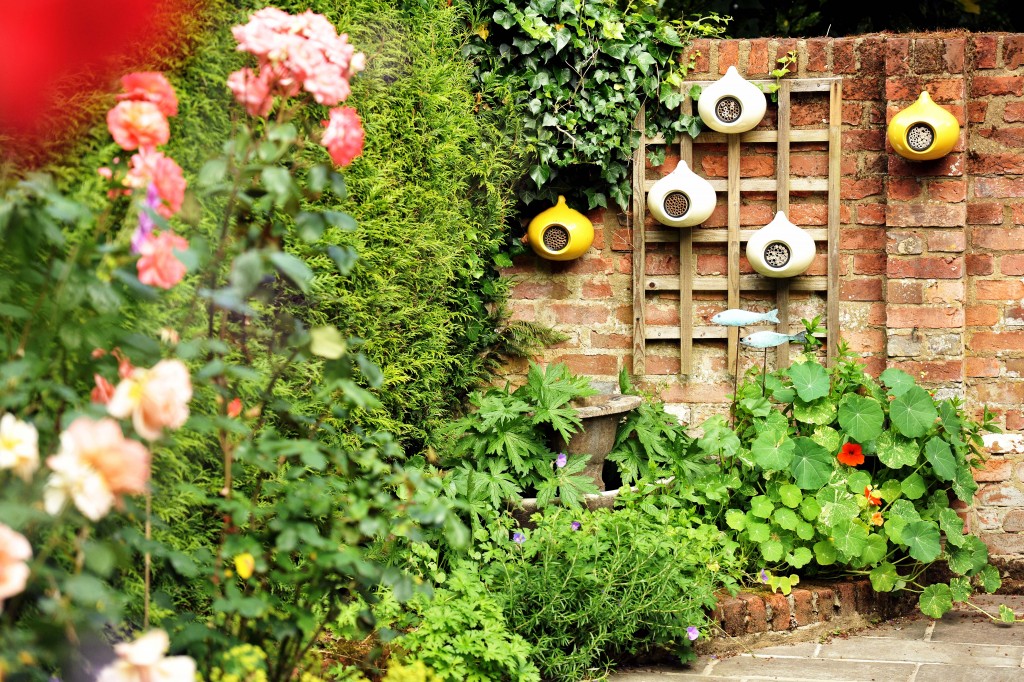
Posted in Garden Landscaping
No Comments »
June 5th, 2014
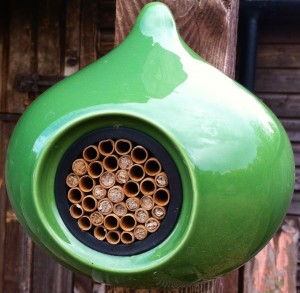
Red mason bees nest in a green beepalace. The full tubes contain up to 10 larvae making this a home to about 170 solitary bees (it takes approx 250 to pollinate an acre of orchard!)
Twitter
Posted in Garden Gift, Garden Landscaping, Gift idea, Pollinator Initiatives, Pollinators
No Comments »
May 22nd, 2014
Posted in Garden Gift, Garden Landscaping, Gift idea, Pollinator Initiatives, Pollinators
No Comments »




















